K: You're a native Californian, correct?
D: Actually, I'm a native Montanan who migrated to California in the great hippie migration of the '60s. I went out several times during the '60s and probably in '66, '67, I decided to hang around and participate.
K: Deniz Tek told me you lived in Laurel Canyon in L.A. for awhile. What was it like?
D: Well, for me it was great. Laurel Canyon in the late sixties seemed to be the center of the Universe as far as I could tell. The people, the talent, the artists and the rest of the young people who had moved out there to be part of a Happening of some kind or another all seemed to be there. It was a microcosm and a macrocosm. You could simply find anything you wanted there, especially drugs.
K: And you were working in music at the time?
D: I had taken a job at a technical repair center called West Coast Organ and Amplifier Company, and had been employed to take care of people's equipment, amplifiers and musical instruments and whatnot. There were three of us there when I started working there, a secretary, myself, and one other man -- his name was Jerry Sanders -- who actually started the business. It seems as though the day after I went to work there, Neil Young walked in.
A lot of famous (or at least now-famous) people began to show up and need things done. The company that we shared the building with was called Golden West Musical Instrument Rentals, and they were the suppliers for all the guitars and amps and organs and synthesizers and the rest of the equipment that would be needed to make records. So they carted the stuff to all the studios in L.A., and of course if it broke, it came next door to our place. Because of that connection, a lot of musicians came to West Coast to get their equipment fixed, and I had brought to West Coast some amplifiers that I had made, I had them sitting on display there as a "calling card." When people saw those amplifiers, they would first ask, "Do you build them?" and I would say, "Yes, I do." Suddenly I would be building someone an amplifier.
K: So you were actually designing and building gear before you worked for West Coast.
D: Oh, yeah. I had been for quite a number of years, and when I went to the interview to be screened for hiring, Jerry asked me what my experience was, and I told him that I had been an amp designer and builder for a number of years, and I had been trained in classical piano and organ music, and could also repair organs and other electronic equipment, and could play them. I got the job immediately, and because of my long hair, he decided that I should stay in the amplifier part and he would go out and take care of the organs, since he would have to deal with people and he wasn't sure that they would be all that comfortable with the holes in my pants and my sandals and my long hair. I readily agreed, thinking, "It doesn't matter to me, I'd be happy to repair amplifiers or go out and fix organs."
I had no idea who the customers were going to be when I took the job, but it wasn't very long till every guitar god in L.A. (or that ever visited there) was in there asking me to do something...either soup up their amplifier or help them get some kind of a sound that they had heard in their head, wondering if perhaps I could put some kind of a circuit or build something that would help them achieve some artistic dream. I'd give it a try; I might even have succeeded a few times.
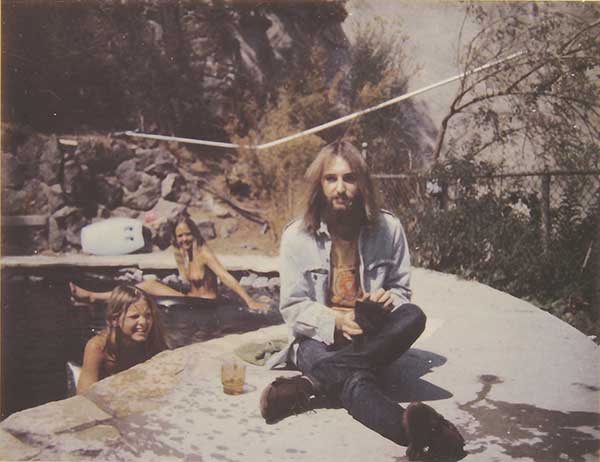 Dave Weyer in his Laurel Canyon days in 1969
Dave Weyer in his Laurel Canyon days in 1969
Neil Young came in a lot of times, and he always had things that he wanted. One day he came in and had a Fender amp with him and his well-known Gretsch guitar that he always played [with the Buffalo Springfield] -- in fact, I think he was working on or had even finished his first [solo] album and I remember I asked him if he was "The Loner"...there was a song on the radio playing; I'd been listening to it and I liked the words to the song, so while I was there I asked him if HE was "The Loner." He didn't even answer me; he looked at me kind of funny and I thought that perhaps I had asked him a question that he was uncomfortable giving me the answer to, and then he told me that it was a song that he had written at a certain time and place and that it didn't necessarily have anything to do with him personally, but I really never did believe him.
K: "No one can see him, nothing can free him..."
D: "Step aside...the Loner." But he brought an amp in that day and said, "Dave, check this out." He brought the guitar in, plugged the amp, played through it some tunes he was working on (that I'd later hear on the radio), and he said, "You see how it SUCKS? This amp sucks." I THOUGHT I knew what he meant, and I said, "Oh yeah, yeah, it really DOES suck. Do you want me to fix it?" He said, "No, no; not THAT kind of sucks...it sucks DOWN when you play these loud chords." I said, "Oh, THAT kind of 'sucks'." He said, "Yeah, I LIKE that. Is there any way to get it to suck MORE?"
Which was power supply compression...the little rectifier tube that supplies the DC power to the amplifier stage was past its ability to deliver current. When that would happen, the voltage would drop, and the amplifier volume would go down and it would get even more distorted, and created this sort of sucking sound. Then as it would restore, the volume would come back up, and the tone would get clearer. And he LIKED the effect, so he asked me to think of a way to make it worse. I decided one good way to make it worse would be to put TWO rectifier tubes in there in series, so it would compound the effect; it would be even WORSE, and I did do that.
Such was born the first dual-rectifier Fender amplifier. Later, a dual-rectifier amplifier became quite famous...the Mesa Boogie amplifier that had dual rectifiers but it wasn't series, they were in parallel, and they were meant to lessen that effect instead of increase it. But I've always credited Neil Young for inventing the first dual-rectifier amplifier in wanting to achieve some particular sonic goal that he had in mind.
And that was very typical of the kind of thing that would go on. People would show me something and then ask me if I could either enhance it or make it more or in many, many, MANY cases, make it louder. It was the hot-rod amplifier shop of Hollywood, California. We were filled with high-powered output tubes and large transformers and for several years there, we kept hot-rodding amplifiers every day. I finally had to hire quite a few more people; I think there were six of us by the time I left to start the Montana Power Amplifier Company on my own. We were doing those things, dozens upon dozens of them.
K: It must have been a challenge taking these kind of subjective or not even verbal specifications and trying to come up with a technical solution.
D: Neil Young told me that one day. He said: "You are an interpreter. You're a translator. You can listen to what musicians say, because you're a musician, and understand what they're talking about, and then you can translate that into some scientific, technical product, because you understand technical things and electronics and scientific ideas."
A lot of what I did there WAS to interpret what they said and convert it into something that could be done realistically with the parts and devices of the day, and put something together. It wasn't a very accurate approximation, but over the long run, things evolved, so you DID get closer to the kind of sound that someone was looking for.
I think that Jimi Hendrix was a pretty good example of someone who was searching for a sound that he didn't even really know what it was, and because of that, he would sort of take the approach that musicians that I've worked with over the years have taken, which is "I will know it when I hear it. I can't tell you what it is, but I know THAT isn't it, and I'll tell you when I hear it, so keep working on it." That sort of thing. Jimi would try all kinds of things to see if any of them worked for him. I would characterize the modifications for Jimi primarily as amplifier upgrades.
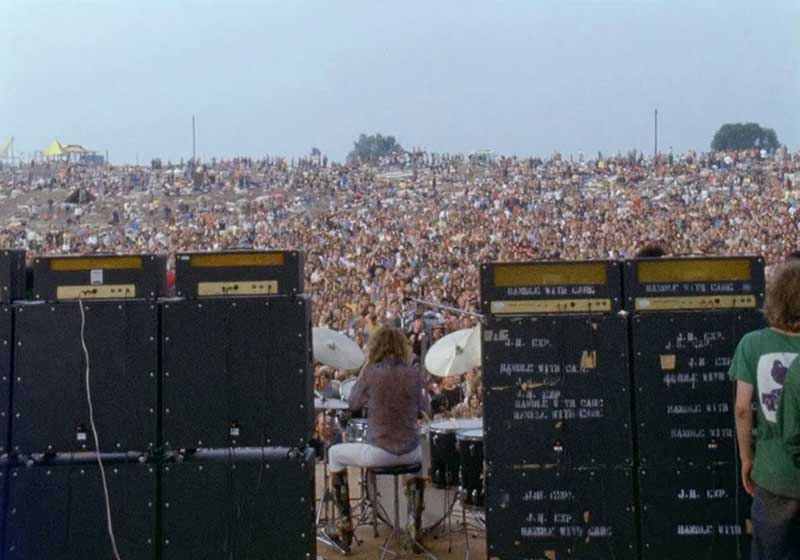
During the late '60s, he moved away from most of the other amplifiers into Marshalls. He let his Fenders go and lots of different equipment. He was, from what I could tell, highly superstitious, and he really liked the name Marshall (that being his middle name) and he felt very comfortable with that name. Since the Marshalls were really nothing but Fenders with larger transformers and higher output, he was very comfortable with the sound. He wanted even more output from 'em for most of the time I knew him.
Nothing was ever quite loud enough...more feedback, more power, to give him the kind of control that he wanted while he was playing. But he did like tone, and he did a lot of experimentation to arrive at tones that he could squeeze into his tunes and his improvisations. So I found plenty of opportunities working for Jimi to refine the Marshall amplifier and to enhance the power output and enhance the tone.
I happened to be a good friend of Bob Hoveland and Brad Plunkett, who were both engineers over at Warwick Electronics, the parent company of Thomas Organ Company and the makers of Vox equipment, as well. Because of that connection, I had a lot of parts available to me from the engineering department at the Thomas Organ Company, and particularly savvy advice from those two talented engineers on how, for instance, to improve the sound of a wah-wah pedal.
Since Brad had invented it, he was perfectly aware of all its functions, and he provided me with some low-noise transistors (which I put in Jimi's wah-wah pedals) which weren't available to anyone else. Those wah-wahs, of course, were produced as cheaply as possible; I think they were probably a $49 device at the time...they had the cheapest of the cheap parts. They had, I think they were Fairchild transistors, and I would get the low-noise high-beta transistors, which had a green dot or a blue dot on them to identify that they had greater current gain, and put them in the wah-wah pedals, which I think pleased Jimi quite a bit, because they weren't nearly as noisy.
I also had access to the small toroids which were in the wah-wah pedal and gave them their particular tone character, and I was able to change those out and make small differences in where the "wah" was -- was it a dark wah, or a highly piercing high wah, and how far from dark to piercing did the wah go, that sort of thing. But Jimi would bring boxes of wah-wah pedals, 15 or 20 in a box, and he would usually have his road people bring them in, and say, "Just go through them all." One of the boys I had working for me, Neil Moser, was a guitar maker, a luthier, and I would set him up with wah-wah pedals. All day long, we would go through wah-wah pedals.
Or Fuzz Faces; Jimi loved the Arbiter Fuzz Face. There was a modification I would do to those that gave them a throatier sound and a little bit different tone characteristics. He didn't really care for the fuzz; all he really used them for was to get more volume. They were like a small preamp. In the older Fuzz Faces, it seemed like if you played the guitar at a reasonable level, it was clear, but if you cranked the knob up, then it got dirty, so you actually didn't have to push the button to make the thing work. There was a lot to that -- if you didn't have the volume on the guitar turned up too far, and the fuzz turned down quite a bit, you could leave the Fuzz Face in the circuit with the button on and play right through it and simply get more gain.
That's what Jimi did. If you listen to his guitar, it isn't all fuzzed out; the sound of those things is very obvious, and I never really did care for it, the fuzz sound. He would bring the same number of Fuzz Faces, a box of 15 or 20, and we would go through them, all new batteries, jacks, pots, whatever it takes, so that when he would go on tour with the Experience, he could pull one out and have a fairly high probability that it was going to operate. If they didn't, he simply tossed them and they ended up in this box. By the time the tours were over, most everything was not operable anymore. They weren't particularly designed for the kind of abuse that they got. The manufacturers of the day couldn't imagine their products being set on fire, or thrown across the stage, or the abuse they got during the showmanship of the day.
K: Deniz tells me you invented several pieces of gear, including the Choratone, the first chorus unit.
D: The Choratone originally came from the Baldwin Piano Company, and it was a device conceived in their electronic laboratories during the '50s. It was a rather large box with quite a number of tubes on it, and it was supplied to their dealers to install on the church organs of the day. Its purpose was to recreate the effect of the viol and the viol celeste on pipe organs, particular string-like sounding pipes that are on practically every pipe organ. And that chorusing...only the pipe organ could do it.
The Choratone was invented as a way of getting around having to have a complete extra set of generators to de-tune to get the chorusing effect that was so popular and used in so much of the liturgical music. Of course, my history with repairing organs and working for Baldwin (which I did, at the factory outlet there in L.A.) put me in contact with these boxes. At first, I simply felt they were sort of a novelty; the way that they had them being installed in churches, I didn't think really added that much to the sound of the organ, but it certainly piqued my interest, and I was determined to get ahold of one of those things and take it home and analyze it to see what it was and what could be done with it.
I eventually had my opportunity; I got one out of a church in North Dakota...they didn't even know what it was for. They got a new organ and I ran off with the Choratone. The first thing I thought was, "What can we do with this thing? How can we make it actually chorus?" I determined to come up with a modification (which I did) that allowed it to be used with a guitar and gave it two outputs instead of one output, one of the outputs being a non-chorused sound and the other output being the chorused sound, and having the phase between those two switchable. Once that was done, and the resulting signal came out of two speakers and two amplifiers, and UNBELIEVABLE chorus was obtained.
I took my Choratones to L.A. when I went, thinking, "Somebody's gonna LOVE this," and they did -- every guitar player that ever plugged in wouldn't leave me alone. Everyone wanted to buy the Choratone, but I couldn't really sell them because I only had two of them. I let them use them, but you can probably imagine a guitar player who has never experienced an effect like that plugging his guitar in and hearing, for the first time, a brand new kind of a sound, with their own strings and their own guitar and their own musical expression, now having access to it. It gave them a tremendous feeling of power. And it was years yet before chorus units would appear. Everyone that I played it to wanted it. Of course! Why wouldn't they? It would set them apart.
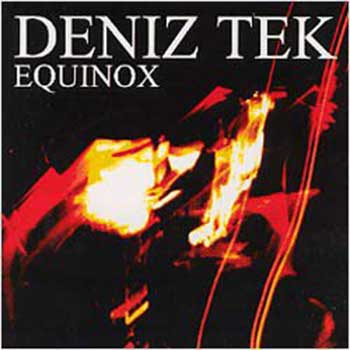 We used the Choratone on Den's "Equinox" album to a great extent, a number of times, and Den had never liked chorus, he said. He always thought it was too fruity. But when he heard the Choratone, he said, "That's the first chorus I've ever liked. Unbelievable." It has a tremendous depth. In the '70s, with the bucket brigade chips that you had on the market, they were able to produce small chorusing units. They started out as phasers. It was the obvious place to start, because that was something that no one had heard before either, except from the flanging of tape recorders in the studio. Gee, I think I heard that when I was just a kid, and I was told that it was Les Paul that got that one going.
We used the Choratone on Den's "Equinox" album to a great extent, a number of times, and Den had never liked chorus, he said. He always thought it was too fruity. But when he heard the Choratone, he said, "That's the first chorus I've ever liked. Unbelievable." It has a tremendous depth. In the '70s, with the bucket brigade chips that you had on the market, they were able to produce small chorusing units. They started out as phasers. It was the obvious place to start, because that was something that no one had heard before either, except from the flanging of tape recorders in the studio. Gee, I think I heard that when I was just a kid, and I was told that it was Les Paul that got that one going.
But the Choratones...I still have one of the ones that I had down in L.A.; I keep it operating in the studio. Of course, they haven't been made for many, many years; I don't know if there are any still in existence. They could be made again, but with the power of microprocessors and the digital delay, there's certainly no reason to have one.
It could be recreated; there's something about plugging into this thing that's all tubes from front to back and the way that it sounds. There's a certain character about it that doesn't seem to be available, at least not in any digital equipment that I've ever come across. I know they're working on it.
Tubes are a rather complex device from a sonic standpoint. From a strictly mathematical standpoint, as far as designing amplifiers goes, they seem to be rather simple. There's a family of curves, and there's a family of formulas, and there's a family of functions and relationships that seem to occur consistently, which gives you the ability to design things with them. Sonically speaking, there's complexities that aren't addressed in any formula or any mathematical function. The audiophile people will attest to that.
K: Why'd you decide to make the transition from a technician/repairman to an engineer/producer?
D: I don't know that I ever did actually make that decision, because I always thought I was an engineer/producer, and I had been doing that as long as I had been building or working on amplifiers. I always played, I always recorded, I always built amplifiers and used them to make music or other strange noises that I consider music with a broad definition.
K: Glass Insects [the experimental Tek/Weyer studio project] comes to mind here.
D: I've always loved noises. Any kind of noise. If I haven't heard it before, it's certainly worth a listen. Noises are music to me, so I certainly don't mind using them in something that's considered music. Equinox...there's even noises in that.
K: You don't hear stuff like that anymore; in the late 60s it was more common. How'd you get the idea of doing that with Deniz?
D: It was almost like, "Oh, here comes a likely candidate." My urge to put those things in is always there. I have to restrict myself with a lot of people because they wouldn't understand and it might frighten or offend them. But when Den came along, because of his background, the kind of music that he came out of, the kind of attitude that came out of that music, I just simply imagined to myself, "Oh boy. Here's a perfect candidate. If he will acquiesce to some of this, I'll go ahead." And whether or not it worked out to the better for him, I cannot say yet, but he did acquiesce, and I hope that the long run proves his own wisdom. Because we did end up with that project, and I was very pleased with how all those things got in there and what they did in there, and what they did for the music and the tunes and the poetry and the expression of all of that.
K: I think your work with Deniz on that album and Bonne Route is really the only work I've heard from an American producer that stands up to what Eddie Kramer did with Hendrix on Electric Ladyland and what Glynn Johns did with the Who on Who's Next. Fantastic records.
D: I wonder if Eddie Kramer would be incensed that someone like me was compared to him. If that's the case, I almost wonder if it isn't simply because of what we were listening to and the goals and aspirations that we had as artists and engineers during that time period when their things were done. I suppose it could be boiled down to something like, "I didn't get to do that then, but Eddie Kramer did, and Glynn Johns did. Whatever they were doing, they got to do it then. I didn't get to do it then, but I got to do it later, and that might go along with what a saxophone player from L.A. said when he heard "Equinox" for the first time. He said, "Oh, wow, Dave's just had a Floydian slip."
K: A little wordplay on Pink Floyd.
D: Yeah. But there may be something to that.
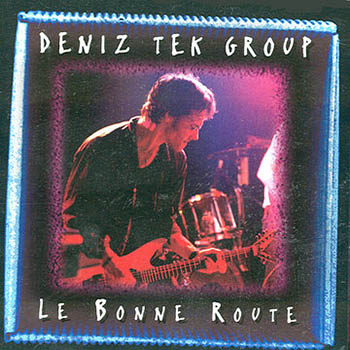 K: Had you heard Radio Birdman and the earlier Deniz Tek records before you did "Le Bonne Route"?
K: Had you heard Radio Birdman and the earlier Deniz Tek records before you did "Le Bonne Route"?
D: Mmm-hmm. Den gave me a lot of the old discs to listen to when we started hanging out, and I wanted to hear where he was coming from, and where he'd been, so I had all that history in me before I started on any project for him. But I knew it was gonna be all right when he said he liked "Trout Mask Replica".
When I found out that those people, and Zappa and others like that were part of the cultural conditioning that he brought with him, I felt very comfortable, and I was anxious, and I probably was pushy, I probably was over the top, because when he wanted to do Bonne Route, I just sort of said, "Here, look. You do it THIS way. This goes here, this goes here, and that goes out there, and who's this Kent Steedman guy? Tell him to shut up, kick him out of here."
K: A lot of Australian fans are probably going to be mad at me for saying this, but as well-respected a producer as Phil Punch is in Australia (for his work with Ed Kuepper and others), I think the sound that you got on "Le Bonne Route" totally destroys the sound he got with the same musicians on "Outside".
D: That was my goal. I had another goal, which maybe I shouldn't have had, but Kent Steedman said, "You'll never do it with digital. You'll never get that kind of sound with digital." And I thought to myself, "Bullshit. I'll get that kind of sound, and I'll also bury that other sound -- not that I'm such a fan of digital, but it CAN get good sound; it doesn't HAVE to be bad."
So there were some goals, and I must say in the end, Kent Steedman made a great contribution to "Le Bonne Route". I don't think it would have been the same without him. I happen to really like some of the things on Bonne Route, I guess because they make me laugh, and I was laughing when I recorded them. We had such a good time with it all.
There were no barriers to experimentation, and you can't have that with a lot of groups and a lot of people; they have to allow the producer and the engineer the same kind of creative input that they want for themselves. Things like Bonne Route...there was a great deal of experimentation. In the end, we got things that came out of that willingness to experiment, and they're very free and they're unencumbered with a lot of worry. We just went for it, and if it even sounded like it would work, we took a chance.
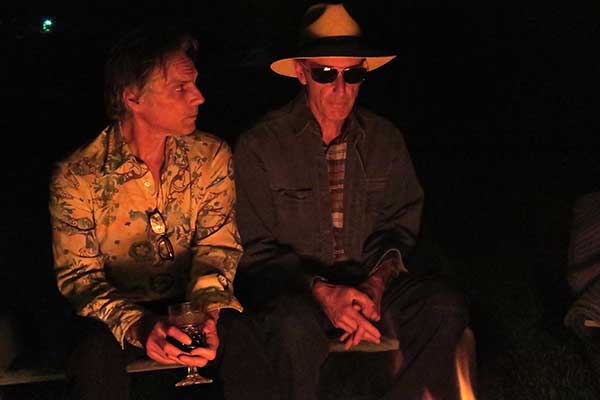 Deniz Tek and Dave Weyer. Anne Tek photo
Deniz Tek and Dave Weyer. Anne Tek photo
Because of the success of that on "Le Bonne Route", when it came time to do "Equinox", Den was even MORE willing...he let me hook up the Choratone, and he allowed me to hook up seven amplifiers and turn them all to 10 for the tune Seven Is, and a number of other things that he was totally open to using. There are certain times in your life when you can say, "Well, I guess I have nothing to lose; let's go for it."
Maybe if you were a very famous act who had achieved its fame with a particular kind of sound and kind of music and style of harmony, you might be afraid to move away from that, because your record company might sue you, or your audience might leave you. In fact, Den did mention several times during the recording of "Equinox": "Well, there go my fans. A lot of people are going to hate me for this, Dave." I hope they don't, in the end. I know there's probably a lot of people that just want to hear the hard rock part of Den forever and ever. It's in there, too; we didn't leave them out.
K: In terms of the recording process, how was "Equinox" different from "Bonne Route"?
D: We were able to take a much more off-line approach. We would store things. We would do things in pieces. We would have sessions where there wasn't any other purpose than to see what kind of feedback tones we could get. There were sessions where none of the musicians were here. There were sessions that occurred with myself and some other friends who didn't even know they were going to be on the album. I recorded a lot of different things.
On the end of "King of the Carnival", when I had people come in and shout, "Hail to the king! Hail To The King! HAIL TO THE KING!" That was my son Will and me and I can't even remember who was in on it, but if people happened to be here, and I happened to be working on something, I'd say, "Hey, come in here. Here's what I want you to do: I want you to take these metal shelf brackets and rattle them." Or, "I want you to stamp your feet to the beat and do the 'Hail to the kings.'" After that was done, I asked Will, my son, to take the role of a hotdog vendor and go through the crowd and shout, "Fresh hotdogs! Get your fresh hotdogs right here! Only seven dollars!"
Den wasn't aware that any of it was going on; no one was. When [bassist/:King of the Carnival" composer] Todd Eagle and Den came in to hear what I had done to the tune, they heard it the first then. Den broke out laughing hysterically. He said, "Oh my God, I can't imagine. Could you please explain to me the phrase 'fresh hotdogs?' How can there be such a thing as a fresh hotdog? Something that is so old and processed? How can there be such a thing?" When Todd heard the tune, he jumped up like a child. He couldn't believe it. He said, "I cannot believe this; I cannot believe that's the tune. Play it again. Play It Again. PLAY IT AGAIN!" I think that's the most I've ever seen him get off.
But that's the kind of work that we did on that record. If something would work, it went in there, and it didn't matter where it came from. I think there is a snare drum hit at the beginning of one of the tunes, and that snare drum hit occurred in the Bull Mountains, which is a small mountain range about 50 miles north from here where I have some property. I invited a drummer friend of mine and friend of Den's, who ended up playing on that record,
Clay Green, to come up to the mountains to a place called Echo Point and play drum stuff for me while I sat down in the valley with a DAT recorder and a pair of XY microphones and recorded during the night after the crickets were done and after the whole area became very still, winds died down and so on. One of the snare drum hits that he did was just monstrous; it echoed down and throughout the canyon. You could hear all of the echoes. That particular one, out of all the drum stuff up there, I took that out and flew it in with Pro Tools and used it as the pickup hit to start the tune...I think it comes in right after that Turkish stringed instrument called the saz that was used on two of the tunes.
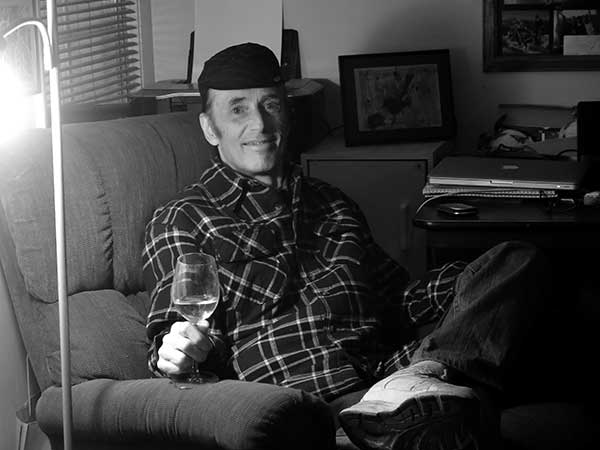 Dave Weyer at home. Anne Tek photo
Dave Weyer at home. Anne Tek photo
K: "Sideways Motion"?
D: You probably remember the tracks better than I do; I just remember the bits. It sounds like a HUGE crack; the snare drum just comes in with this CRACK and big echo after it, and of course it's all acoustic stuff recorded from the mountain. It was that kind of thing, where we were able to collect all of this stuff that we thought was sonically worthwhile, that everyone said was cool, and we had this bucket of parts and pieces, and I tried to thread them into a tapestry, or even patchwork quilt, where you take things that aren't necessarily related and relate them, and by their geometric design they become relative...that sort of thing.
K: Let's talk about some of the musicians in the Deniz Tek Group...you mentioned Kent Steedman in particular and his contribution to "Le Bonne Route". How would you characterize that contribution?
D: You've stumped me for a word there. If I had to pick one word, I think I'd pick the word "inscrutable." It's very difficult to quantify his contribution. It's definitely there, and Kent had a very strong background in the kind of music that he does...
K: The real aggressive hard rock of the Celibate Rifles...
D: He brought that feeling with him. In some ways, he and I ended up in conflict because he appeared to believe that he was going to produce the record, which would have us going two different directions at the same time. So, it wasn't without conflict, but I think I found a way to work within it and work around it to allow Kent to have the exposition of his ideas occur and still not interfere with what I wanted to do with their sound. I did relegate myself to a lesser producer role on "Le Bonne Route" and applied my efforts more perspicuously towards getting ballsy guitar sounds and otherwise interesting guitar sounds and LOUD guitar sounds and still carve out a place for strong drums.
What I had initially felt about Den's work with Kent and Bino [Nik Rieth] and Jim [Dickson] was that the guitars took it all and the drums were left out. It may be stylistic; I've never been sure whether or not the reason that the guitars had so much space and the drums so little was that it made it sound as though it was bigger. In other words, it made it sound like you were in a club or something where the guitars so dominated the drums that the comparison between the two would let you realize how MONSTROUS the guitars actually were, and I wonder if there wasn't a stylistic reason for doing it that way.
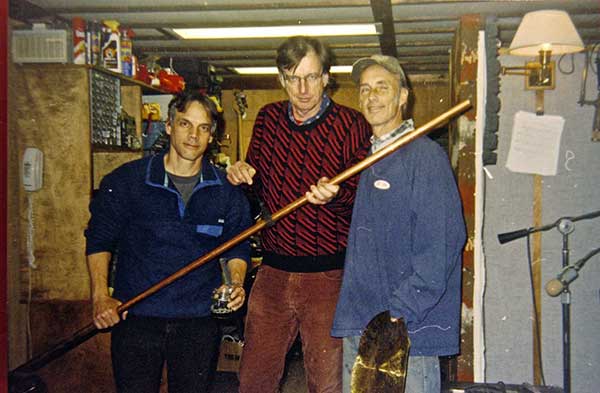 Deniz Tek, Jim Dickson and Dave Weyer using a long copper pipe to make sounds during the recording of the (as yet unreleased) "Glass Insects 2"
Deniz Tek, Jim Dickson and Dave Weyer using a long copper pipe to make sounds during the recording of the (as yet unreleased) "Glass Insects 2"
The approach I wanted to take was to have the guitars sound just as monstrous, and STILL have the drums sound monstrous too. If not use the drums as a way to compare how loud the guitars were; to find your sense of power somewhere else. That was what I would say my greater goal with that album, and since Kent wanted a strong hand in production, I could let him have musical ideas and dominate other areas that we had worked on, and I could work on the area of getting that sound and getting the guitars up AND the drums, and getting Kent's guitar up there where he liked it, where it sounds very, very powerful. Kent likes to have his guitar where it sounds very, very powerful. That was the approach I took: How can you get them to sound powerful without using weak drums as a comparison? That's kind of how we went about the album.
Kent added a lot of energy to it, and he had a lot of good ideas. He had me hooking up things that I probably didn't want to hook up. One of them was one of those tiny Marshall amplifiers that are about four or five inches tall, and they have a small transistor amplifier in there, you plug it in, and there's a tiny speaker. He wanted me to plug that in to one of the channels we were using, and then run the signal into THAT thing, and then put a microphone in front of it and pick the signal up and insert it back into the channel.
It was on the "Rabbits' Foot" tune. The one where each person takes a part of the tune and has a bit that they've written...Den is trying to shove an oyster down the slot of a pay phone, and Jim does his little bit, and Bino does his about the underpants, and each voice is put through some ridiculous contraption.
Den's voice came through that little amplifier, and the microphone picked it up and put it back in the channel. Bino went through a tremolo unit. Each voice went through some kind of little guitar box, filled with noise and garbage and whatever effect it would add with that. And the little bits that they wrote just tickled me to death; I just loved the poetry. Kent was a big part of that tune..."Eating peanuts in the springtime/Could get them caught in your intestine..." Lines like that that Den would NEVER write. I don't know ANYONE that would write something like that, but Kent Steedman. It still tickles me to this day, so I have to thank him for his contribution.
K: In a similar way, Todd Eagle had a lot of creative input (songs, vocals) on "Equinox".
D: Todd DID have a great contribution, particularly in his bass playing. The grooves that were set up in "Equinox" are really not of the same realm that Den had been used to working in. Todd came out of a funk band, and so did Clay, so funk-rock came into the equation. Thanks to that, there were new kinds of grooves; it was definitely a fusion, didn't you think?
K: It affected Deniz' playing, too; some of the rhythm parts and syncopations he played on tunes like "Aqua Caliente", "Christmas Eve" and "Hit 29" were very different than what I'd come to expect (although you could hear them foreshadowed in "Bonne Route"'s "Salted Leeches").
D: Another testament to his wisdom: his willingness to be dislodged from the old familiar ground. I LIKE that, because we were cutting new ground, and therefore there were thrills, there was excitement, and no one knew in advance what kind of a tune it was going to be. No one knew really WHICH direction it was going to go. The kind of lounge thing [Hit 29]...I didn't know there would be anything like that. I don't think Den did either, and I don't know if anyone imagined it would be a lounge kind of feeling in that tune; that kind of came up inadvertently, almost adventitiously. It rose spontaneously out of the energy that was there in the basic track, almost as a sideline.
K: Todd's influence is definitely evident on the limited-edition "Got Live" set from the Australian tour, where Deniz is playing in the three-piece with Jim and Nik. The lead playing is different than things Deniz used to play previously, and he's doing some of those funky rhythm things, even though he's playing with the old rhythm section.
D: That's fun when you hear someone adopt and adapt...adopt new things and new styles, and adapt to new environmental circumstances. Den seems to love it. He's not hardened into a particular sentimentality for that era that he was formed in, which makes it easy to make records with him. Of course, the difference in "Bonne Route" and "Equinox" is that I didn't really have to answer to anyone on "Equinox".
I wanted to take the sound of the instruments the way we had gotten them to sound loud and big and strong, and yet all able to share the mix, and bring that into "Equinox", and then add all the rest of the "Floydian slips" that I did, these kinds of things that I knew Den liked, because by the time that "Equinox" came around, I had had a chance to sit around the stereo and drink Spatenbrau Optimators with Den until the wee hours of the morning, listening to the Stooges, listening to Captain Beefheart, and listening to other things that Den aspired to. So with all of that, I formulated a plan for "Equinox" that would hopefully keep the good sound, and improve upon that, add the new musical styles, and then bring in all of these other elements and sort of beef up proto-punk rock to a sophisticated place.
K: I think you quite succeeded. Moving ahead a little bit...talk a little bit about side project Glass Insects.
D: Let me go back to the tune "Seven Is". When we had these seven amplifiers set up out in the big room; I call it the "multi-purpose room"...there's a large room outside of the studio, connected to it of course, with a cement floor and a wooden ceiling and wood walls. It's got a bit of echo and a lot of early reflection in there, and I like to put amplifiers out in that room. It's very live. So we had assembled a group of seven different-sounding amplifiers...some Montanas that I had made when I was in California, that I had the opportunity to re-purchase and bring back to Montana some 25 years after having made them; Den's amps; various speaker boxes and so on; of course the Choratone; a 1948 Fender Deluxe that I'd had for a number of years, that I'd found in a pawnshop...a whole collection of things.
After we got done with the basic track, I just sent Den out into the big room and said, "Just get out there. I don't care what you do. Put 'em all on 10 and get out there, and get in the middle of the amplifiers somewhere." So he did. Went out into the room and of course the feedback was just unbelievable. It's a balancing act to keep the guitar from going into not just string feedback but to electrical feedback from the pickup itself, but there was all of this screeching and squeaking and railing and Den had the guitar on the floor of the shop and he was kicking it and it was sliding across the floor, and of course I was happily recording all of this stuff. I used a bit of it on Tone Poem; the background for that poem was some of this feedback that was done out there in the big room.
The idea for Glass Insects actually occurred to me during that period of time: "Maybe what I should do is invite Den over. Before he comes, I'll hook up a whole bunch of stuff and we can just plug in and turn on the tape machine and see what happens. And I'll make it as interactive as I possibly can, so that if you move this way, this happens, if you move that way, that happens, if you turn this knob, this happens, and if you turn that knob, that happens. Therefore, there won't be any way to predict what happens. We'll just plug in and see where it goes." So that was the original idea -- to kind of make a Seven Is sort of feedback solo, but add other elements in. Add the Choratone, and add a Leslie speaker, and add one of those old bucket brigade delay lines that had a lot of various controls on it, different functions. Hook it all up at once and start playing around.
So I did. I called up Den and said, "Hey, Den, I got an idea. Why don't you come on over, bring a guitar, or bring a few guitars if you like and we'll just do a freakout jam and do whatever you want." So he was more than happy to come over, and he showed up and brought his guitars and we went into the studio, and I turned on the computer with Pro Tools, and we plugged in, and let it wail.
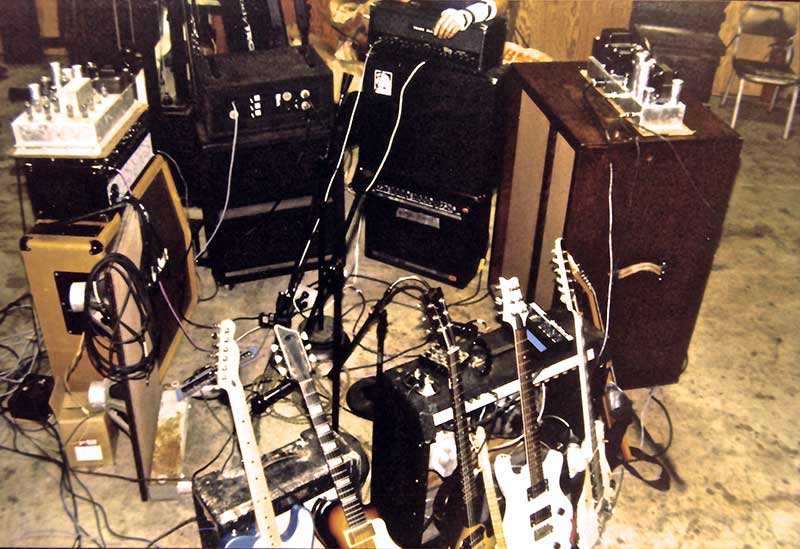
K: There are parts of that tape that remind me of John Coltrane and Pharaoh Sanders on Meditations or one of those free jazz records from the late 60s, where they just go out, playing atonally, but at the same time, you can hear themes that recur, and you can hear them playing off and responding to each other.
D: That's kind of how it went. You're not the first one that has said that exact thing. I'm GLAD there's that quality to it. We didn't really know what we were doing, except LAUGHING. And there are times where, if you listen very carefully to that mix, it's buried, but you can still here Den's and my conversation in a couple of places. There's even a laugh in one place, and Den's saying in one spot, "That's the coolest thing I've ever heard in my life," after I plugged in a microphone -- he calls it the "Daveophone" now -- I plugged a microphone into an Ampeg VT-40 and I had the output of the VT-40 going into the Choratone, whose output went into another speaker cabinet, and by moving the microphone between the Ampeg and the other speaker cabinet and changing the midrange gain on the VT-40, the microphone began to "sing" its own tune, and it sounded for all the world like a saxophone playing atonally. In those sections, I think there are three sections where I've done that in there, and at the end, the instrument that's playing at the end is this microphone/Choratone feedback thing.
Because of the nature of the Choratone -- it is a 1-2-4-8 modulator; it modulates 1, two times a second, four times a second, and eight times a second. Those particular modulations set up the patterns. And as the phase would shift, the microphone feedback sequencing would also shift in this sort of rhythmic pattern. That's what occurred there, and Den was standing there while this was going on, laughing. He would try to lock into the rhythm of it; you hear the guitar come on to the rhythm of it and try to find this complex pattern of rhythm and lock into it several times. He would fall into it and then of course he would fall away out of it, and then he would try to get back into it again. You can hear that on there, too, as he tries to play along with it. Finally, he just gives up; his mouth drops open, and then at the end of that, he says, "That's the greatest thing I've ever heard in my life."
That's how that came around, and it wasn't intended for an album, honestly. I had imagined that we would take those parts and maybe use them in Den's next album here and there. But when Jim Dickson came over from Australia with Bino to record Angie [Pepper]'s album, one night after the session, I said, "Hey, Jim, check this out," and I put it on, and I do believe Jim went into another dimension. When it was finished, he said, "That whole 30 minutes is the greatest thing...that is unbelieveable. You MUST make that into an album unto itself. Don't change it, don't do anything to it; it's the greatest thing." And I think it still gets him off just as much that way. After he said that, I looked over at Den and said, "Hey, Den, there go the rest of your fans."
So he decided we would put it out and call it "Glass Insects", because he felt it was like if there were glass insects crawling across a mirror, or sliding; there were those scrapes and those tappings that sounded so glass like to him; they sounded like they were buzzing as well, their wings. We sat there for awhile and said, "Who in the world would hate this the most? Who would find NO value whatsoever in this?" And the answer was, 11-year-old girls, and it became, then, "Music for 11-Year-Old Girls"; that was Den's suggestion for the title. That's its title to this day: "Music for 11-Year-Old Girls by the Glass Insects". (And the sequel can be "Music for 12-Year-Old Girls".)
I'm still kind of amazed when I hear it that this sort of trail of crumbs that you follow, that Den was looking for something and he'd hear something, or something would feedback, or something would start playing back retroactively, and it would send him in the particular direction, and then he would just start playing around with something. That one part, which to me is extremely beautiful, where it gets quiet, and there's this guitar...he's just hitting the bridge with his fingers on the strings on the chord, and then he's hitting the bridge, and it's causing these ringing-in-the-distance beautiful chords to occur. It was going through the Choratone and I'm just astounded by the incredible beauty of it. I played that to him later; I said, "Den, check this out -- you're not going to believe how beautiful this one section is." That section recurs, I think two or three times during the whole course of that. He gets back into that, in fact it's into the underlying section at the end, where the "Daveophone" (as Den calls it) is playing. The fun part about it is it's got a recurring theme. In the midst of all this cacophony and randomness, there's some recurring themes. The first time we listened to the whole thing, it seemed to follow the mind's own desire to make things into sections and to revisit and to thematically postulate, because when it was all said and done, it seemed to organize itself along those lines.
K: I'd like to talk about a couple of other projects no one has heard yet...the Angie Pepper EP and the Native American music project.
D: Those have yet to go through the Dave machine. I have basic tracks (and scratch vocals on the Angie Pepper project). I have a strong commitment from Den to work on the Angie Pepper project this coming season -- in fact, as soon as I can find some time to book the time in the studio for that. Also, the Last Days of Summer Indian flute project -- what's he calling it?
K: "Spirits Calling" is the working title I saw.
D: That one needs to be done too; hopefully those will be done this winter. The Angie Pepper one certainly has a life and character of its own. I'm not sure where it's going, either, but I CAN tell you that we'll probably take the same approach on it as "Equinox", and that is to kind of sense what the spirit is of what was laid down by Bino and Jim when they came over, and see where that direction is and kind of run with it that way. It's an interesting group of songs, and it's a departure for Jim and Bino as well. Got to working on them this time, too.
Before that project got going, I got ahold of a CD of hip-hop breaks and grooves and old black funk stuff and R&B, some house, and techno...all kinds of groove. And I gave that to Bino when he got over here and I let them sit with that up at Den's where they rehearse, and my suggestion was, "Buy into this stuff. Hear it. Get some of this stuff in your blood. Learn several of these things." And Bino was just like a student in medical school. He sat down there everyday in the rehearsal room, learning these grooves, learning how to play them on the drums, and then making his own out of them. He would learn them, and then he would "Bino-ize" it; put his own feeling into it, his own way of playing. So when Bino came to do the tracks, you didn't have the same Bino that you would have expected.
K: That might also account for some of the different playing that we hear on "Got Live!"
D: It might indeed. And of course, Clay has had an influence on Bino as well. He's been able to pick up a number of things from Clay, which is good for Bino. That helps him grow, too. And Clay, on the other hand, who I can characterize as a sophisticated drummer, very familiar with world beat, a percussionist -- when he heard and saw the video of the Celibate Rifles, he was amazed, and he has praised Bino ever since as this monstrous drummer with power, energy, and that has had a marvelous effect on Clay.
So here are two musicians who come from different parts of the world and come from different musical experiences and listen to different genres, who come together and learn from each other and influence each other -- both for the positive. It's a good cross-pollination, and it has been good for Den's music and good for his records.
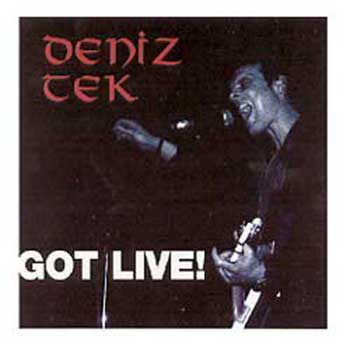 So there may be some truth to what you say about "Got Live!" Of course, one of the genetic mutations of that would be that Bino had to play Clay Green parts and he did pretty good, I thought. So when I heard those DAT tapes of "Got Live!" for the first time, I couldn't believe what Den was doing...how much of what was on "Equinox" he was trying to grab.
So there may be some truth to what you say about "Got Live!" Of course, one of the genetic mutations of that would be that Bino had to play Clay Green parts and he did pretty good, I thought. So when I heard those DAT tapes of "Got Live!" for the first time, I couldn't believe what Den was doing...how much of what was on "Equinox" he was trying to grab.
And I said when he got back, "Den, how did you REMEMBER any of that? I mean, this stuff was a long time ago and there were lots of guitar parts that you were able to sort of collate all of it into a guitar part that you could sort of grab and do with a three-piece. I didn't think he would take that approach at all. I'm surprised that he did, that he took on such responsibility to try to do that.
K: It kind of reminded me of Zoot Horn Rollo in the Magic Band, when they went from two guitars to just one, and he would take two guitar parts and kind of fuse them together into something he could play by himself. Interesting, that. Deniz will probably hate me for asking this, but...you've worked in different capacities with three very creative, intense artists whose approaches vary greatly -- Jimi Hendrix, Neil Young, and Deniz Tek. How would you compare working with those three individuals.
D: If the key word here is "working," it's not really that much of a comparison, because it was GOOD working with each one of them. Each one of them worked with you; each one of them had something they wanted to do on their own, but each one cooperated with me to a very deep level in order to be able to get what they wanted to. In that respect, they're a lot alike.
K: And the differences would come where?
D: Well, of course the differences are their musical creativity...but there are some similarities there, too. Did they all want loud? Yes, they did. Did they all want tone? Yes, they did. Did they all want to go beyond the state of the art? Yes, they did. In those respects, they're very similar. Of course, you have, with Den, someone who'd been influenced greatly by Jimi Hendrix, and even Neil Young, for that matter, if Neil Young truly is the father of grunge, there are certainly aspects of that that Den admires, and I think particularly the poetry. Because Den is a good poet. I suppose you've thought about this and talked about it. It hasn't been mentioned here today, but I probably should bring that in, that some of Den's tunes remind me of ("All Along the) Watchtower", which wasn't necessarily Jimi's own poetry, but there was an element of "Watchtower" in me when I did "Christmas Eve".
K: Yes, I can hear that parallel.
D: Something had taken me there in that tune, and as far as the comparison goes...you have three people (had with Jimi) whose basic sound was a Fender amplifier in a high level of saturation and distortion. All of them really start there with their sound. And there's of course other amps, but that basic quality was there in all of them, and they spent a lot of time with their guitar playing chords and rhythm where that amplifier is essentially in complete saturation.
There is a uniting quality between the three of them -- they went their different directions, and they WERE different directions, but there's even corollaries or parallels...think about the kind of rebellious Neil Young, and then think about the Birdman stuff. There's definitely that. Think about the psychedelic blues of Jimi Hendrix, and then drop into "Equinox" and hear Den get into some of that same stuff. I guess it's easy to have a comparison when you kind of have a progeny. I don't think Den will mind being compared to either of them.
K: To close with something a little lighter, since we ARE in a bar...what do you like to drink?
D: Spatenbrau Optimators. It's a dark beer from Munich. That's the best one I've found, and I think Den will concur. We went through quite a number of those on various occasions trying to lock in a direction, because Den wanted to do another album, but he didn't exactly know which direction it should go. So it's entirely possible that that dark beer from Munich, Germany, is responsible for the direction that Equinox went. I never thought to factor that in, but it may indeed have had an effect.
I still have a couple of empty bottles of Spatenbrau sitting up on the shelf in the studio that I kept from that session...I didn't keep them as a reminder of the session; I kept them because if you put them in a plastic sack and let them bonk together, they make an amazing sound. There's no doubt that when the Angie Pepper session gets into full swing, some of those beers will be over here, and if we can't get them, we will second for Guinness Draft.

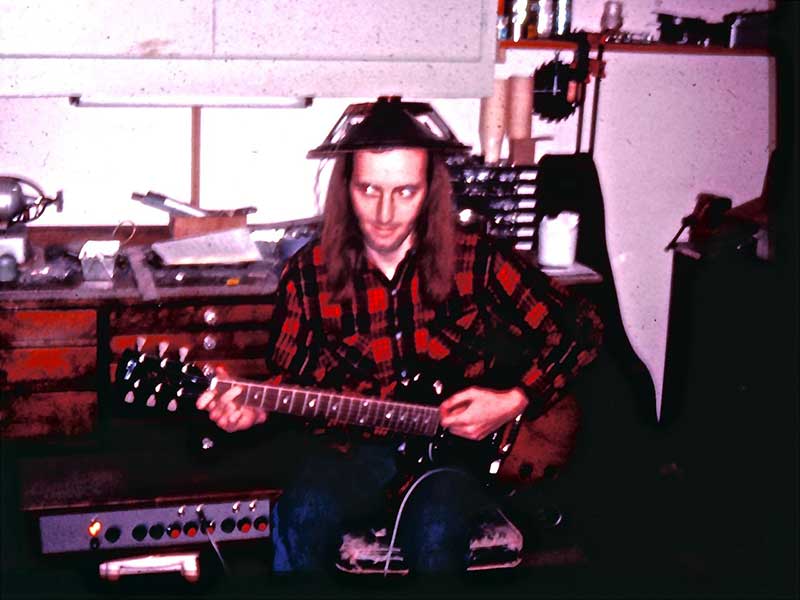 Dave Weyer circa 1969: Sought after Hollywood sound architect.
Dave Weyer circa 1969: Sought after Hollywood sound architect.